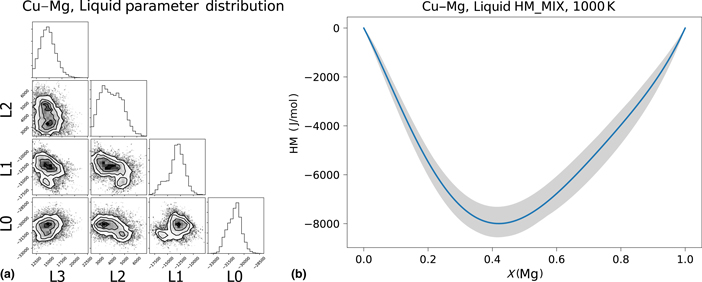Crossref Citations
This article has been cited by the following publications. This list is generated based on data provided by
Crossref.
Guéneau, Christine
Asta, Mark
and
Sundman, Bo
2020.
Comprehensive Nuclear Materials.
p.
814.
Honarmandi, Pejman
and
Arróyave, Raymundo
2020.
Uncertainty Quantification and Propagation in Computational Materials Science and Simulation-Assisted Materials Design.
Integrating Materials and Manufacturing Innovation,
Vol. 9,
Issue. 1,
p.
103.
Liu, Zi-Kui
2020.
View and Comments on the Data Ecosystem: “Ocean of Data”.
Engineering,
Vol. 6,
Issue. 6,
p.
604.
Bocklund, Brandon
Bobbio, Lourdes D.
Otis, Richard A.
Beese, Allison M.
and
Liu, Zi-Kui
2020.
Experimental validation of Scheil–Gulliver simulations for gradient path planning in additively manufactured functionally graded materials.
Materialia,
Vol. 11,
Issue. ,
p.
100689.
Bocklund, Brandon
Otis, Richard
Egorov, Aleksei
Obaied, Abdulmonem
Roslyakova, Irina
and
Liu, Zi-Kui
2020.
Erratum to: ESPEI for efficient thermodynamic database development, modification, and uncertainty quantification: application to Cu–Mg—CORRIGENDUM.
MRS Communications,
Vol. 10,
Issue. 4,
p.
702.
Zhong, Jing
Chen, Li
and
Zhang, Lijun
2020.
High-throughput determination of high-quality interdiffusion coefficients in metallic solids: a review.
Journal of Materials Science,
Vol. 55,
Issue. 24,
p.
10303.
Ostrowska, Marlena
and
Cacciamani, Gabriele
2020.
Thermodynamic modelling of the σ and μ phases in several ternary systems containing Co, Cr, Fe, Mo, Re and W.
Journal of Alloys and Compounds,
Vol. 845,
Issue. ,
p.
156122.
Liu, Zi-Kui
2020.
Computational thermodynamics and its applications.
Acta Materialia,
Vol. 200,
Issue. ,
p.
745.
Zomorodpoosh, S.
Bocklund, B.
Obaied, A.
Otis, R.
Liu, Z.-K.
and
Roslyakova, I.
2020.
Statistical approach for automated weighting of datasets: Application to heat capacity data.
Calphad,
Vol. 71,
Issue. ,
p.
101994.
Kadkhodaei, Sara
and
Muñoz, Jorge A.
2021.
Cluster Expansion of Alloy Theory: A Review of Historical Development and Modern Innovations.
JOM,
Vol. 73,
Issue. 11,
p.
3326.
Wang, Yi
Liao, Mingqing
Bocklund, Brandon J.
Gao, Peng
Shang, Shun-Li
Kim, Hojong
Beese, Allison M.
Chen, Long-Qing
and
Liu, Zi-Kui
2021.
DFTTK: Density Functional Theory ToolKit for high-throughput lattice dynamics calculations.
Calphad,
Vol. 75,
Issue. ,
p.
102355.
Otis, Richard
Bocklund, Brandon
and
Liu, Zi‐Kui
2021.
Sensitivity estimation for calculated phase equilibria.
Journal of Materials Research,
Vol. 36,
Issue. 1,
p.
140.
Lin, Yu
Saboo, Abhinav
Frey, Ramón
Sorkin, Sam
Gong, Jiadong
Olson, Gregory B.
Li, Meng
and
Niu, Changning
2021.
CALPHAD Uncertainty Quantification and TDBX.
JOM,
Vol. 73,
Issue. 1,
p.
116.
Abrahams, Katrin
Zomorodpoosh, Setareh
Khorasgani, Ahmadreza Riyahi
Roslyakova, Irina
Steinbach, Ingo
and
Kundin, Julia
2021.
Automated assessment of a kinetic database for fcc Co–Cr–Fe–Mn–Ni high entropy alloys.
Modelling and Simulation in Materials Science and Engineering,
Vol. 29,
Issue. 5,
p.
055007.
Ladygin, V.
Beniya, I.
Makarov, E.
and
Shapeev, A.
2021.
Bayesian learning of thermodynamic integration and numerical convergence for accurate phase diagrams.
Physical Review B,
Vol. 104,
Issue. 10,
Otis, Richard
Bocklund, Brandon
and
Liu, Zi‐Kui
2021.
Sensitivity estimation for calculated phase equilibria.
Journal of Materials Research,
Vol. 36,
Issue. 1,
p.
140.
Yang, Songge
Wang, Yi
Liu, Zi-Kui
and
Zhong, Yu
2021.
Ab initio simulations on the pure Cr lattice stability at 0K: Verification with the Fe-Cr and Ni-Cr binary systems.
Calphad,
Vol. 75,
Issue. ,
p.
102359.
Khorasgani, Ahmadreza Riyahi
Kundin, Julia
Divinski, Sergiy V.
and
Steinbach, Ingo
2022.
Reassessment of mobility parameters for Cantor High Entropy Alloys through an automated procedure.
Calphad,
Vol. 79,
Issue. ,
p.
102498.
Liu, Zi-Kui
2022.
Theory of cross phenomena and their coefficients beyond Onsager theorem.
Materials Research Letters,
Vol. 10,
Issue. 7,
p.
393.
Gong, Rushi
Shang, Shun-Li
Sun, Hui
Janik, Michael John
and
Liu, Zi-Kui
2022.
Thermodynamic Modeling of the Pd-Zn System with Uncertainty Quantification and its Implication to Tailor Catalysts.
SSRN Electronic Journal ,
